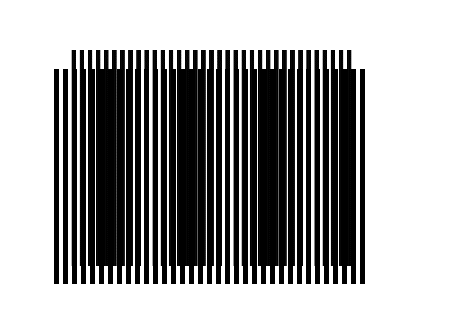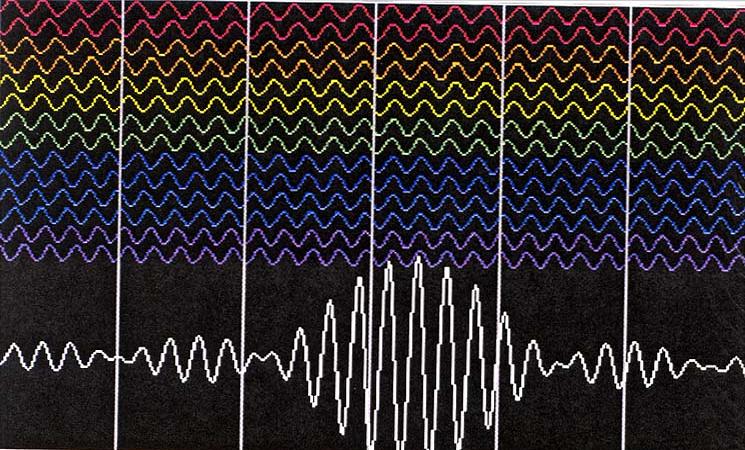FASTER THAN LIGHT, PART II
One fairly difficult concept of
physics that has been in the news a
lot lately is the group velocity of waves, and specifically of
light waves. Almost all reports on recent experiments with varying the
group velocity of beams of light, as covered in newspapers, or on TV or
on the Internet, have been in whole or part total gibberish.
 |
First, let's try to understand
the concept of a group velocity with a simple
analogy. Consider the scissors at the left of this paragraph. If the
scissors
are not animated, hit reload to get them to close a few times. Holding
a real
pair of scissors in your hand as you read this is not a bad idea too!
Focus your attention on the blades; open and close them a very, very
short
distance. Now focus your attention on the point where the blades
intersect.
You will see that even when the tips of the blades move a negligible
distance, the
intersection can move for almost the entire length of a blade. The
speed of
the intersection point is many, many times the speed of a single blade,
for
most scissors. The intersection point motion is analogous to a group
velocity,
while the blade motion is analogous to a so-called phase velocity.
|
In other words, suppose we are
looking at two or more waves, with different
frequency and wavelength. If we superimpose the two waves, we will
see regions where the two waves add to produce a larger wave, and
regions
where they almost cancel out. If both waves travel at the same speed,
this
pattern of "interference" moves along with them. But something very
interesting
happens if the two waves move at different speeds. Then the pattern
moves
in a dramatically different way from either wave; it can move much
faster; it
can move much slower; it can move backward while the waves move
forward.
The velocity of this pattern is the group velocity. The actual velocity
of
each wave is its phase velocity. In the animation below, a
Moiré
pattern is used
to illustrate how two waves of different wavelength and speed can
interfere to
produce a "group" pattern that moves backward compared to either wave,
and at a totally
different speed!

To really understand any
phenomenon in physics, you need to play!
Since you are sitting at your computer, a good way to play with group
velocity is to play
with a group velocity applet, and here is
one, and here is
another.

Clicking on the slightly cock-eyed
image above will
take you to another applet that shows (with text explanation included)
how a large train
of waves of different wavelength can combine to give groups that move
faster than
any of the waves. Let the applet run awhile and you
will see how eventually a large group appears that moves much
faster than the actual waves creating it are moving.
If you can figure out how to get each different
wavelength of light to move very differently in a special material, you
can create a pulse that can have
any
speed from plus infinity to minus infinity, or that appears to stand
completely still!
Over the past 5 years, news media
have reported how
experimenters constructed a gaseous medium with such properties that
when a pulse
of light began to enter one side, the same apparent pulse was already
leaving the other
side, as if moving much faster than light or even violating causality.
All that was happening
was that the various wavelengths entering the material started moving
each at a very
different speed (in each case less than the vacuum speed of light), the
differences being contrived so that that the original pulse
disappeared, while a similar pulse was constructed by superposition
among the much-shifted waves that happened to be leaving at the same
time the original group
was entering. The same thing can be done in reverse; that is, you can
contrive the
superposition changes so that the pulse entering the material becomes
apparently
"frozen" in position or moves at a snail's pace. Light that apparently
does not
move at all is certainly a novelty. Understand, however, that in all
these experiments,
the light is in a gaseous medium and the phase speed is slower
than the speed of
light in a vacuum. The interesting effects are due to the fact that
each different
wavelength moves at a different speed in the medium, the
familiar
phenomenon of
dispersion, which in this case allows the resulting
groups to move
in very startling ways... startling, anyway, to science-illiterate
science reporters. Some writers do a better job, fortunately. Faster
than light?
Account 1,
Account
2.
Frozen light?
Account 1,
Account
2.
Next?


